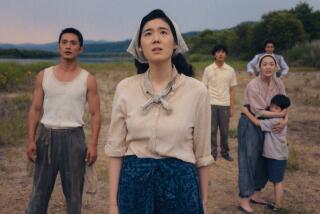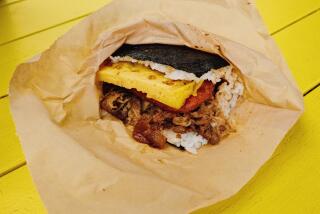Controversial Theory Traces Japanese Emperors’ Roots to an Old Korean Town
- Share via
PUYO, South Korea — Every year, thousands of Japanese tourists visit this small, dusty city in the countryside to view artifacts in a rather nondescript museum and hike up a piney hill where the last of the great Paekche kings was subjugated in AD 660.
A Waikiki or a Disneyland it is not, but for Japanese archeology buffs, this ancient capital in western South Korea reminds them, eerily, of home.
“The atmosphere is special,” said Hideyuki Shishido, a Japanese journalist based in Seoul who ranks Puyo as his favorite place in South Korea. “It’s somehow very familiar to us.”
Grudging Recognition
Behind the mysterious allure of Puyo is a grudging recognition among some cosmopolitan Japanese that the forebears of their civilization did not, as legend holds, descend from the Sun Goddess, but almost certainly crossed over to the Japanese islands from the Korean Peninsula.
It is a controversial theory, owing to longstanding enmity between the two Asian neighbors. However, archeological evidence and historical records lend strong support to the theory that the Japanese imperial line itself is an offshoot of the Paekche Dynasty, which reigned over southwestern Korea from the 1st Century BC until its last defenders perished on the hill in Puyo 1,328 years ago.
It may sound sacrilegious, but many scholars believe that Hirohito, the ailing Japanese emperor, and his son, Crown Prince Akihito, are as Korean as kimchi --the garlic-loaded pickled cabbage that is this land’s most notorious food.
The irony has not been lost on the South Koreans, who are now awakening to a new sense of nationalistic pride following rapid economic growth and the successful hosting of the 1988 Summer Olympics. Although they generally despise comparisons with the Japanese, they delight in pointing out that their former colonial masters had been a primitive and illiterate people before the conquering Paekche horsemen gave them Chinese writing, Buddhism and what was, by the standards of the 4th Century, advanced technology.
“Japan is an economic superpower now, and you can’t help but see it as the center of power in Asia,” said Hong Won Tack, a professor at Seoul National University. “But 2,000 years ago, everything was flowing down from the continent, and Japan was a dead end.”
Hong, a distinguished economist who moonlights as an amateur historian, has launched a campaign to debunk the myth of ancient Japanese dominion on the peninsula, which imperialists used to help justify Japan’s annexation of Korea in 1910.
“For the continued peace of East Asia, the Japanese should know all the historical facts,” Hong said. A latent sense of racial “purity, uniqueness and superiority” among the Japanese, he believes, has ominous potential.
The truth about Japan’s imperial roots, according to an interpretation of records and myths that Hong laboriously cites in a book published earlier this year, is that the first Yamato emperor was in fact a 4th-Century Paekche prince named Homuda-wake or Onjin.
Sees Battle as Evidence
Loyalty to the home clan in Korea was what motivated Onjin’s descendant, the 7th-Century Empress Saimei, to dispatch 10,000 troops and 100 warships to help Paekche’s army defend itself against aggression by a rival Korean kingdom, the Shilla, and its Tang Chinese allies, Hong concludes. The Japanese contingent ultimately was destroyed alongside Paekche’s forces.
His view is consistent with the thinking of many Western specialists in Asian history, but Japanese academics have been generally reluctant to examine the matter. The Japanese Imperial Household Agency, an arcane and rigid bureaucracy, prefers to leave the origins of the Chrysanthemum Throne shrouded in mystery and has opposed opening major archeological sites that might offer definitive evidence.
Tomb Excavated
But Korean links were highlighted by the excavation in Japan this fall of the 1,400-year-old Fujinoki tomb in Nara, the old Yamato capital. Archeologists found several artifacts, including a crown and a pair of gilded slippers, of likely Paekche origin.
Hong, who holds a doctorate in economics from Columbia University, said he felt compelled to depart from his field of expertise and tackle the historical conundrum because Japanese taboos on the topic still prejudice the thinking of South Korean scholars.
“Korean historians haven’t emancipated themselves yet” from 35 years of forced Japanese education, Hong said. “It takes an outsider like me, without any preconceptions, to document a new model for analysis.”
Kim Sung Gu, director of the National Museum at Puyo, said there “is still some doubt” about the theory that the Yamato emperors came from Paekche. But he said modern Japanese and Koreans unquestionably have a common cultural and linguistic heritage, with the flow going east.
“Visiting Japanese see Puyo as their spiritual homeland,” Kim said. “If they come to South Korea, they invariably make the trip to Puyo.
“As a citizen of Puyo, I’d like ordinary Americans to know that this is where you find the cultural roots of the Japanese,” Kim said. “But our culture is not something we need to propagandize as the Japanese have done for so long. In time, people will know.”
More to Read
Sign up for Essential California
The most important California stories and recommendations in your inbox every morning.
You may occasionally receive promotional content from the Los Angeles Times.












